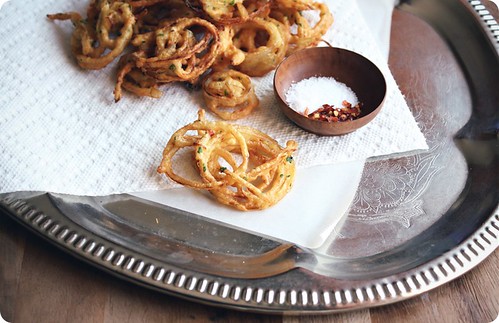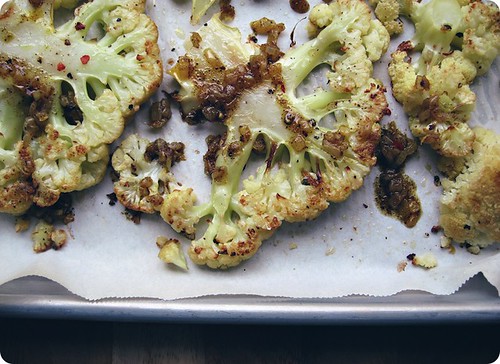My exact favourite
 Tuesday, March 16, 2010 at 9:19AM
Tuesday, March 16, 2010 at 9:19AM I was granted the gift of a decent ability to remember things. My capacity for recall has served me well enough; through years of English Lit exams, countless passwords and PINs, phone numbers and postal codes, and all the other scraps of information deemed vital these days.
For the longest time, I had my brother's Social Insurance Number memorized. I was without specific reason to do so, I just did.
Mysterious how the mind works. Doubly mysterious how it sometimes chooses to abandon you completely. In my case? That memory of mine has one specific failing, and a funny one at that. Pakoras.
It's not that I've forgotten them, that would be impossible. Those vegetable fritters were one of the reasons that ours was the most popular house for after-school snacks on our street.
My grandmother and mother made them with onions or with sliced potatoes most often, sometimes with cauliflower too. Crisp and tender, touched by spice, they were like onion rings and potato chips and french fries all rolled together, made that much better by the combination.
Sitting at the table, I'd concoct an accompaniment to the pakoras as we waited for them to be cooked. The glass bottle of ketchup and a plastic bottle of chili sauce was all it took. You'd pour some ketchup into a little bowl, then stir in a swirl of firey-hot chili sauce, being as miserly or as generous as you'd like. That's it, that's all, you were ready to go. (This sauce is not at all authentic, but the thing to a six-year-old palate.)
My preferred pakoras were onion ones. They would emerge from the oil open-weaved, with rings of onion coiling around each other. In those few spots where the batter collected, the pakora was soft and fluffy; where the batter was thin, it shattered with a delicate crunch.
Trouble is that Grandma, the maker of superlative pakoras, firmly disavows these lacy versions of my childhood memory as her intended result. For a split second I foolhardily considered a defense of my recollection, but you don't argue with Grandma.
Of course the mistake was mine.
As I examined this lapse in my reminiscence, I had two epiphanies. First, my well-documented greed is probably at the root of this. I wouldn't be surprised if my childhood self (or my adult self for that matter) saw it fit to only select the thinnest, snappiest, pakoras of the bunch; only those ideal specimens would have been squirreled onto my plate.
Second, I shouldn't expect myself to be a faithful narrator to this story. It is inherent to the nature of our most treasured childhood memories that they be viewed through the blurred lens of nostalgia. Of course it would be that in my recollection every pakora was my exact favourite.
Lucky for me, pakoras are not only in my memory. And now that I'm the one at the stove, I can indulge my fancy and make sure that every pakora out of the oil is, in fact, my exact favourite kind. Yes, I know, greedy of me. Again.
But I'll sit with spine straight and head high. To me, these are memory brought to life, or to our plates to be specific, with the bias of sentiment fully, marvelously intact.
Indian Onion Fritters
Pakoras are often made with a batter that includes a variety of spices and a leavening agent. This is my Grandmother's recipe, who believes that simplicity is best when appreciating the qualities of each ingredient. As I said, you don't want to contest her opinion; I'm smart enough to be a good little granddaughter and report it faithfully.
Since I do deviate from tradition in the way they are shaped, I've called these fritters to avoid any confusion. Ramshackle and rustic, the messier your clumps of onion, the more texture there will be in the finished fritter.
For the full pakora experience of my childhood, the ketchup chili sauce combination is a must.
Ingredients
1/2 cup gram (chickpea) flour
1 small red chili, seeded and minced
2 teaspoons minced cilantro
A generous 1/4 teaspoon kosher salt
Water
Oil for deep frying (peanut, vegetable or canola)
2 medium onions, trimmed, peeled and sliced into thin rings horizontally
Salt and fresh lime wedges for serving
Ketchup and chili sauce for serving (optional, see above)
In a medium bowl, stir together the flour, chili, cilantro and salt. Slowly stir in enough water until the mixture reaches the consistency of whipping (heavy) cream. Beat the batter well, so it is lightened and foamy at the edges. Set aside.
In a heavy-bottomed pot on the stove or in a deep fryer, heat oil to 350°F (175°C). When that's reached temperature, separate the onion layers into individual rings and drop them into the batter, stirring gently to coat. Using a fork, pick up a clump of onion rings and allow the excess batter to drip off.
Carefully drop the tangle of onions into the oil and fry until lightly golden on one side, around 30-40 seconds. Flip the fritter and cook until crisp on the other side. Remove from the oil and drain on a cooling rack set up over newspaper or on some folded paper towels.
Repeat, frying a few at a time, until all the onion and batter is used.
Enjoy immediately, with additional salt sprinkled over and a squeeze of lime juice. Offer a condiment of ketchup blended with chili sauce for dipping.
Serves 2-4, depending on appetite. To be safe, let's say 2.
Notes:
• A small amount of crushed dried red chili can be used in place of the fresh.
• Pakoras can be made with a variety of vegetables. Melissa has some phenomenal versions to offer.






















